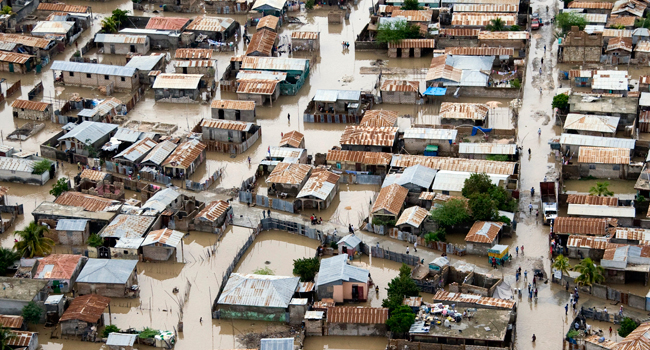
Located on the western side of the Hispaniola Island - which it shares with the Dominican Republic - Haiti is a mostly mountainous country. The country has lost most of its forest cover and is thus prone to erosion processes. It has also been increasingly affected by natural disasters such as hurricanes and tropical storms and also by floods and droughts, the impacts of which are aggravated by unsound urbanization practices, the use of natural resources and waste management. The population, two thirds of which depend on the agricultural sector, is highly vulnerable to climate variations. Haiti is still recovering from its most severe earthquake in 200 years, which hit the country in January 2010. The most vulnerable sectors to climate change are: agriculture and land degradation; coastal zones; and water management.

Timelines of the NAPA preparation process in Haiti
| Funding for the preparation of the NAPA approved by the GEF |
January 2003 |
| GEF agency approval date |
April 2003 |
| NAPA preparation start |
March/April 2003 |
| Submission of the NAPA to the UNFCCC |
December 2006 |
NAPA projects under implementation
Haiti defined eight priority activities. A project addressing the adaptive capacities of coastal communities was developed as Haiti's first project under the LDCF. This project consists of four components:
1. Systemic, institutional and individual capacity development;
2. A sustainable financial framework for Climate Risk Management (CRM) in coastal areas;
3. Piloting of on-the-ground coastal adaptation measures;
4. Knowledge management, codification of best practices and dissemination.
| Project title: Strengthening adaptive capacities to address climate change threats on sustainable development strategies for coastal communities in Haiti |
| Implementing agency |
UNDP |
| National executing agency |
Ministry of Environment |
| Cost in USD million (LDCF component/total cost) |
3.960/11.060 |
In addition, a second project aimed at reducing disaster risk in agriculture to improve food security was developed in February 2010. The intention was to grant expeditious processing following the January 2010 earthquake. The latest information available seems to indicate that this project is finally following the normal LDCF project cycle after the PIF was resubmitted in February 2011.
| Project title: Strengthening climate resilience and reducing disaster risk in agriculture to improve food security in Haiti post-earthquake |
| Implementing agency |
FAO |
| National executing agency |
Ministry of Agriculture |
| Cost in USD million (LDCF component/total cost) |
2.999/8.230 |
| First submission of the concept note (PIF) under the LDCF |
February 2010 |
| Re-submission of the concept note (PIF) under the LDCF |
February 2011
|
| GEF CEO endorsement of the project |
Not CEO endorsed yet |
NAPA PROCESS
Preparation and implementation strategy: The NAPA preparation process took place in an unstable political context and, due to increased security threats, public consultations were difficult to organize. Despite this difficult context, the NAPA team carried out the consultations and succeeded in organizing all of them, but this resulted in a longer NAPA preparation time frame than initially expected.
Consultation with communities and local authorities was considered a very important step, as this provided complementary and additional information, as well as an opportunity to discover which adaptation measures the communities had already adopted. The NAPA team also worked in cooperation with the national communication team to share information on the country's vulnerabilities to climate change, which made for consistent reporting.
 |
Institutional arrangements in the country: Soon after preparing the NAPA, Haiti experienced many institutional changes, which resulted in the activities of the NAPA team being interrupted between 2006 and 2008. Today, Haiti's objective is for all ministries to fully integrate climate change issues into their respective sectoral national plans.
Experience with project implementation: As the NAPA was moving from the preparation phase to the implementation phase, UNEP - which had helped the NAPA team to prepare the document - was replaced by UNDP. To facilitate the working relationship with UNDP, a platform was created to share technical information, but the national team felt that the agency could have shared more information on finance, particularly on strategies to mobilize co-financing partners. The NAPA team also thought that the procedures for CEO endorsement of the full project proposal were lengthy, as the process took almost two and a half years (August 2008-December 2011).
Similarly, since the second project was initially developed and processed in an expeditious manner on account of the impact of the earthquake, the GEF agency (FAO) took the lead in elaborating the document and, as a result, the national team felt excluded from the process. A lack of meeting spaces, owing to the fact that a number of government buildings had been damaged, may have hampered communication even further. For both projects, the GEF agencies coordinated all financial issues, including the mobilization of LDCF resources and other sources of funding as part of co-financing.
Revision and update: Haiti did not initially consider revising or updating its NAPA, but after a string of natural disasters (one hurricane in 2007, three in 2008 and a major earthquake in 2010), a lot of information and data are no longer considered accurate. It is now felt that a revision/update of the NAPA could provide an opportunity to re-assess the country's priorities regarding its adaptation to the most adverse effects of climate change and, as such, the process would be supported by the institutional framework which was established for the preparation of the NAPA. However, Haiti would consider revising and updating its NAPA only if it is an expedited process that does not take more than six to eight months to complete and does not impede progress in implementing NAPA projects that are currently underway. |
| Haiti's experience shows that continuous engagement of the NAPA team during the design of the implementation phase is critical to avoid any delays in implementation and nurture the capacity that has been built during the preparation phase. |